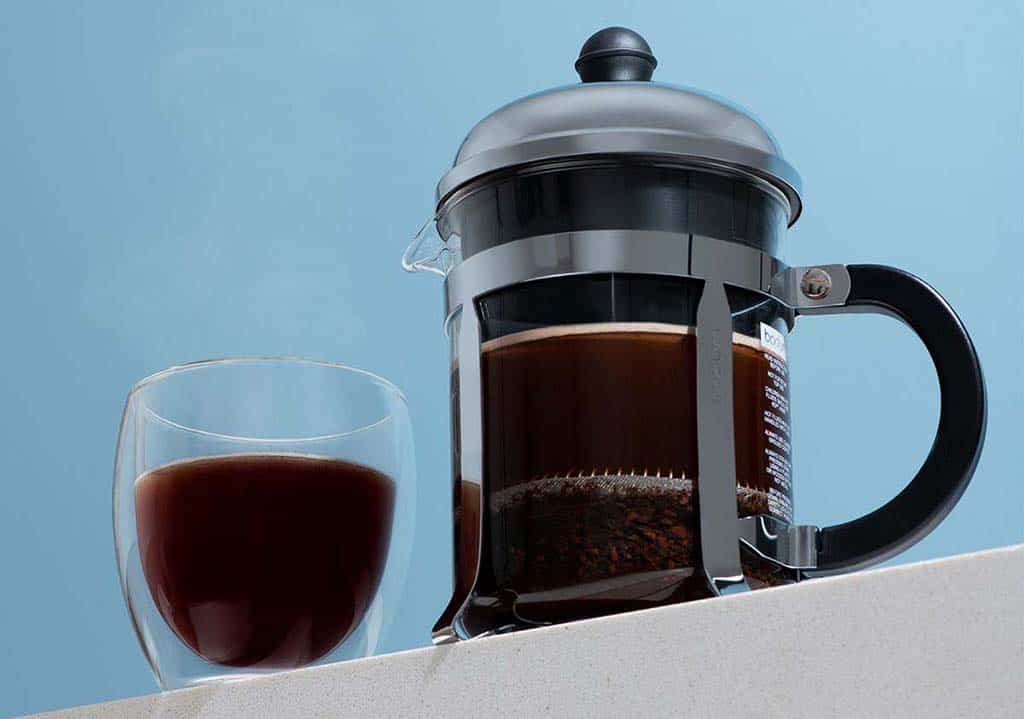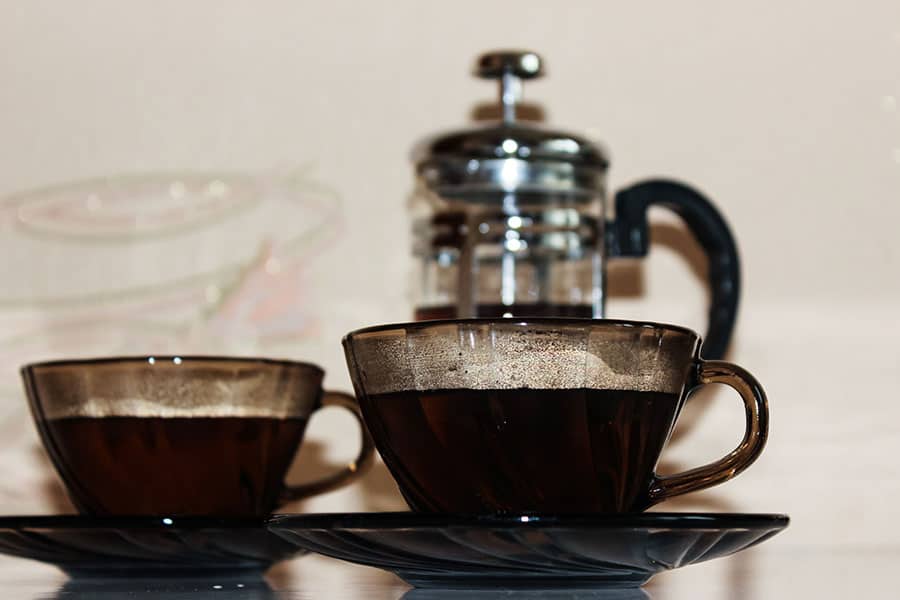How to Use a Bodum French Press: A Step by Step Guide
 Table Of Contents
Table Of ContentsYou deserve a great cuppa joe to start your day, and if you thought only barista-brewed coffee can jolt the heart, you’re wrong. Making a great cup of coffee from home is now easier than ever, but not many people know that, so today, I will show you how to use a Bodum French press to make great coffee.
Maybe you’re wondering why Bodum coffee press and not pour-over, drip, or Aeropress coffee? I’ll explain.
You can count on each of these methods to help you brew delicious coffee, but you’ll have to pay close attention to detail for great results — not to mention the use of custom paper filters.
Well, you don’t have to worry about any of that when using a Bodum coffee press. It’s easier to operate and makes better-tasting coffee. Actually, that is what attracts coffee lovers to it, and I have to admit, nothing else probably comes close to the home brewing experience that Bodum French presses offer.
But don’t take my word for it. Here’s a chance to learn how to use it and see everything for yourself.
What Is a Bodum French Press?
The brand Bodum has earned the trust of coffee lovers across the world. Right now, this is one of the few go-to brands for great French Press coffee makers.
The Bodum French press was born after the manufacturer incorporated the French press system into one of their coffee makers. Now we have an impressive coffee maker that brews deep-flavored, delicious coffee. And here’s the best part: You have a variety of shapes, sizes, and colors to choose from.
Available sizes include:
- 0.35 liters (12 ounces)
- 0.5 liters (17 ounces)
- 1 liter (34 ounces)
- 1.5 liters (50 ounces)
All Bodum French presses use a mesh filter that you depress all the way to the bottom of the glass container, after which the ground coffee is separated from the brewed coffee.
How Does a Bodum Coffee Press Work?
If you have never used this device before, I have news for you. Using a Bodum coffee press is one of the simplest things you will ever encounter in your coffee preparation experiences.

The entire process can be summed up in just two words: Immersion brewing! I’ll explain it.
Just to be clear, this is a manual brewing process. Once your fresh coarse ground coffee beans complete the brewing process, the lid is put back and the plunger depressed thereafter. What happens next is the coffee grounds get filtered to the bottom of the Bodum coffee press, leaving you with the final product: a delicious cup of coffee.
Now, at the bottom of your cup, expect a bit of sediment and/or grit. That’s because a significant amount of the organic compounds and oils in your coffee beans will find their way into the final product after brewing and pressing.
How to Use a Bodum French Press
Tools Needed
- A coffee grinder
- Kettle
- Coffee stirring spoon
- Coffee cup or mug
Ingredients
- Your preferred coffee beans
- Fresh water
Bodum French Press Directions
- Place your Bodum coffee press on a flat, non-slip, heat-proof surface and then lift off the lid
- Heat it beforehand by pouring hot water into the beaker
- Get the right proportion of coffee beans
- Using your kettle, heat up the freshwater to about 200 degrees Fahrenheit (or 95 degrees Celsius)
- Grind your coffee beans coarsely
- Measure the ground coffee depending on the size of your French press (for example, use 55 grams or roughly four tea tablespoons for a liter French press)
- Dump out the warm water in your beaker and then add the ground coffee
- Pour the hot water into the French press
- Use the coffee spoon to stir and put the lid back
- Leave the mixture to brew for about four minutes
- Gently push down the plunger until it gets to the bottom of the beaker
- Voila, your coffee is ready — open the spout and pour your freshly made drink into your cup of coffee
One more thing: Don’t leave your freshly made French press coffee in the beaker for too long. Doing so will only yield a drink that is bitter.

Tips for Best Results
- Do not overfill the French press; leave about an inch of space.
- Pour the heated water into the beaker in a circular motion to ensure your ground coffee beans are evenly covered.
- Only make use of coarsely ground coffee; a fine grind will most likely clog your filter and cause high pressure.
- Avoid using metal coffee spoons as they can chip, scratch, or crack your beaker.
- Lower the plunger gently and with minimal pressure to get great results and prevent scalding liquid from shooting out of the French press.
- Properly clean your Bodum coffee press after the brewing process.
FAQs on the Bodum French Press
What is the difference between a French press and a Bodum?
A French press is a manual coffee brewing device that lets you prepare coffee in a glass container by brewing, pressing, and pouring over the finished product.
Bodum, on the other hand, is a brand that incorporated the French press style into their coffee makers to create the Bodum French press.
You will come across so many other French press brands, but only a few come close to the quality and results that Bodum French presses deliver.
What size Bodum should I buy?
Just to remind you again, Bodum French presses come in different sizes, the more common ones being 1.5 liters (50 ounces), 1 liter (34 ounces), 0.5 liters (17 ounces), and 0.35 liters (12 ounces). Each takes a different amount of coffee, with the higher capacity French press taking the most (80 grams).
Choose a size that matches your personal preferences. For example, you can go for the 0.35 liter (12 ounce) French press if your target is only one cup or mug of coffee. But if you plan to brew coffee for about three or four people, then the obvious choice is the 1.5 liter (50 ounce) French press.
Keep in mind that prices vary based on the size. You will pay for the higher capacity Bodum French presses and vice versa.
Is Bodum French press microwavable?
A Bodum coffee press consists of a few parts, some of which are not microwavable. One of them is the plastic base. It would obviously melt off if exposed to such heat.
Other parts include the plunger and lid. These two are made of metal, so this disqualifies them from being microwavable. It’s actually dangerous to microwave metal.
This leaves us with one part: the Bodum glass container. Even though it is strong enough to withstand such heat, you won’t have a way to handle it without roasting your fingers.
On top of that, the borosilicate glass beaker cannot effectively withstand drops and impacts. This means that you are likely to suffer a huge loss if you do this without proper care. However, if you figure out a way to handle it, just make sure it is separated from the rest of the parts.
Can you put Bodum in the dishwasher?
All parts of the Bodum coffee press, from the lid and beaker to the plunger and filter, are dishwasher safe. And no, it’s not a complicated process; just rinse each of them and your tools will be totally ready for the next task.
Remember not to use very hot water as it could melt the plastic base. Also, handle the beaker carefully because it is made of glass that may not hold up well after an impact or drop.
How do you make cold brew with a Bodum?
This is best done by the Bodum Bean Set Cold Coffee Brewer. Just like the Bodum French press instructions, the ones for a cold brew are pretty simple as well. Here’s how to go about it:
- Lift off the plunger from your cold coffee brewer and make sure it is on a flat surface
- Add your coarse coffee beans, but double your normal use for a hot brew
- Pour fresh water into the beaker and stir with a spoon, preferably a plastic one
- Put the lid back on and make sure it is locked in the right position
- Place the device in a refrigerator and let the coffee brew for about 24 hours
- Your cold brew coffee is ready to be served
Ready to Use Your Bodum?
Thirteen steps sound like a lot, but they are so simple you could carry them out in just under eight minutes. The brewing itself only takes about four minutes, so the other three minutes are enough for you to boil water and get the right proportion of ground coffee beans.
No technical skill is required; just make sure you have a bit of energy left in you to press down on the plunger. More importantly, remember to follow all the tips we mentioned so as to experience the best results.
Owen is a writer and editor at Caffe Streets who considers himself a coffee fanatic. He spends his time researching and testing different coffee beans and brewing methods and sharing what he learns with others.





